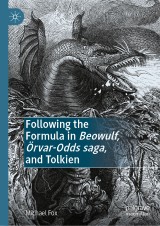Details

Following the Formula in Beowulf, Örvar-Odds saga, and Tolkien
|
CHF 106.50 |
|
| Verlag: | Palgrave Macmillan |
| Format: | |
| Veröffentl.: | 21.09.2020 |
| ISBN/EAN: | 9783030481346 |
| Sprache: | englisch |
Dieses eBook enthält ein Wasserzeichen.
Beschreibungen
<p></p><p><i>Following the Formula in Beowulf, Örvar-Odds saga, and Tolkien</i> proposes that <i>Beowulf</i> was composed according to a formula. Michael Fox imagines the process that generated the poem and provides a model for reading it, extending this model to investigate formula in a half-line, a fitt, a digression, and a story-pattern or folktale, including the Old-Norse Icelandic Ö<i>rvar-Odds saga</i>. Fox also explores how J. R. R. Tolkien used the same formula to write <i>Sellic Spell</i> and <i>The Hobbit</i>. This investigation uncovers relationships between oral and literate composition, between mechanistic composition and author, and between listening and reading audiences, arguing for a contemporary relevance for <i>Beowulf </i>in thinking about the creative process.</p><br><p></p>
<div><div>1. Chapter 1: <i>Beowulf</i> and Formula.- 2. Chapter 2: The Half-Line Formula: <i>weox under wolcnum</i> (8a).- 3. Chapter 3: The Fitt Formula: Genesis and Fitt 1.- 4. Chapter 4: The Digressive Formula: The Sigemund-Heremod Digression.- 5. Chapter 5: The Folktale Formula:<i> Beowulf </i>and <i>Örvar-Odds saga</i>.- 6. Chapter 6: The Formula Reformulated: <i>Sellic Spell</i> and <i>The Hobbit</i>.- 7. Conclusion.</div></div><div><br></div>
<div><p><b>Michael Fox</b> is Associate Professor in the Department of English and Writing Studies at Western University in London, Ontario, Canada. He has published on modern rhetoric, medieval Latin, and Old English.</p><br></div>
<p></p><p><i>Following the Formula in Beowulf, Örvar-Odds saga, and Tolkien</i> proposes that <i>Beowulf</i> was composed according to a formula. Michael Fox imagines the process that generated the poem and provides a model for reading it, extending this model to investigate formula in a half-line, a fitt, a digression, and a story-pattern or folktale, including the Old-Norse Icelandic Ö<i>rvar-Odds saga</i>. Fox also explores how J. R. R. Tolkien used the same formula to write <i>Sellic Spell</i> and <i>The Hobbit</i>. This investigation uncovers relationships between oral and literate composition, between mechanistic composition and author, and between listening and reading audiences, arguing for a contemporary relevance for <i>Beowulf </i>in thinking about the creative process.</p><br><p></p>
Relates to translation studies and adaptation studies Examines Old English linguistic and poetic traditions Considers the connections between the Beowulf tale and folktales
<p>"This book is an extraordinarily detailed study of the concept of formula, at every level from phrase to narrative and even to theme. It is especially revealing to have this applied to three quite different, but strongly related works: an Old English poem, an Old Norse saga, and Tolkien’s <i>Hobbit</i>. He gives us an unrivalled insight into the way both ancient and modern authors worked, consciously and unconsciously.” (Tom Shippey, Emeritus Professor, Saint Louis University, USA, and author of <i>Laughing Shall I Die: Lives and Deaths of the Great Vikings</i> (2018))</p>
<p>"With an encyclopedic range of reference, <i>Following the Formula </i>argues persuasively for investigating the role of formula as method itself in traditional literatures. Fox's penetrating readings of <i>Beowulf, Örvar-Odds</i> <i>saga</i>, and Tolkien's fiction show how productive this approach can be.” (Katherine O'Brien O'Keeffe, Clyde and Evelyn Slusser Professor of English Emerita, Universityof California, Berkeley, USA)</p>
<p>“Fox describes a method of reading and composition that reaches back into the origins of European storytelling, a method that worked for <i>Beowulf</i> and for J. R. R. Tolkien. Fox takes his reader from the smallest phrase, through nested motifs, scenes, and plots, to the formulaic patterns of myths themselves. Norse sagas, ancient Germanic languages, early medieval Latin—all play recurring roles in a gripping analysis built on the very formula that underlies <i>The Hobbit</i>. Highly recommended to anyone who wants to understand ancient storytelling techniques.” (Stephen Harris, Professor of English, University of Massachusetts, Amherst, USA)</p>
<p>“This learned and engaging book unlocks the intricate artistry of <i>Beowulf</i>,<i> </i>demonstrating subtle and meaningful repetitions and variations at the level of diction, half-line, fitt, digression, and theme. Fox also unearths fascinating new connections with Germanic alliterative verse, biblical tradition, heroic legend, Norse saga, and folktale. This is a book that all <i>Beowulf </i>scholars will want to read.” (Francis Leneghan, Associate Professor of Old English, University of Oxford, UK, and author of <i>The Dynastic Drama of Beowulf</i> (2020))</p>
<p>"With an encyclopedic range of reference, <i>Following the Formula </i>argues persuasively for investigating the role of formula as method itself in traditional literatures. Fox's penetrating readings of <i>Beowulf, Örvar-Odds</i> <i>saga</i>, and Tolkien's fiction show how productive this approach can be.” (Katherine O'Brien O'Keeffe, Clyde and Evelyn Slusser Professor of English Emerita, Universityof California, Berkeley, USA)</p>
<p>“Fox describes a method of reading and composition that reaches back into the origins of European storytelling, a method that worked for <i>Beowulf</i> and for J. R. R. Tolkien. Fox takes his reader from the smallest phrase, through nested motifs, scenes, and plots, to the formulaic patterns of myths themselves. Norse sagas, ancient Germanic languages, early medieval Latin—all play recurring roles in a gripping analysis built on the very formula that underlies <i>The Hobbit</i>. Highly recommended to anyone who wants to understand ancient storytelling techniques.” (Stephen Harris, Professor of English, University of Massachusetts, Amherst, USA)</p>
<p>“This learned and engaging book unlocks the intricate artistry of <i>Beowulf</i>,<i> </i>demonstrating subtle and meaningful repetitions and variations at the level of diction, half-line, fitt, digression, and theme. Fox also unearths fascinating new connections with Germanic alliterative verse, biblical tradition, heroic legend, Norse saga, and folktale. This is a book that all <i>Beowulf </i>scholars will want to read.” (Francis Leneghan, Associate Professor of Old English, University of Oxford, UK, and author of <i>The Dynastic Drama of Beowulf</i> (2020))</p>
Diese Produkte könnten Sie auch interessieren:

The Enigma of Good and Evil: The Moral Sentiment in Literature
von: Anna-Teresa Tymieniecka
Preis: CHF 354.00
-
-
© 2024 media control GmbH
Alle Preise enthalten die gesetzliche Mehrwertsteuer. - AGB
- Impressum
- Datenschutzerklärung
- Kontakt
- FAQ
- Mein Konto
- Home
- Erweiterte Suche
- Widerrufsrecht
- Reader-Software
- Desktop-Ansicht
- Gutschein-Code einlösen

